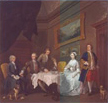Once in a while a display happens along which seems to capture the imagination and encapsulate the mood of both museum assistant and visitor alike. Restless Times, now showing at Tate Britain is very much in that mould. A pared-down version of a successful exposition first shown at the Millennium Gallery, Sheffield and Norwich Castle in 2010/2011, it is grouped around four key themes: Experiences of War, Finding Home, Daily Struggles and Inner Worlds. It offers up a glimpse into the artistic production of a nation passing through profound political and socio-economic upheavals in the years 1914 to 1945.
Working in the galleries and exhibitions on a regular basis, one can become a little blasé about the collection, but this is one display that I cannot but help revisit on an almost daily basis. I think what has most struck a chord with me are the similarities, particularly in the space given over to Daily Struggles, with the current policies of cultural and economic retrenchment. The paintings, photographs and sculptures depict the quotidian, economic struggles of working people from the Crash of ’29 and the lengthy slump that ensued, which was only to end with the mobilisation for world war. Standout pieces from Percy Horton, Henry Moore and Humphrey Jennings provide the spectator with a unique insight into the nature of working-class culture in the early twentieth century. Along with a timely reminder of the cyclical nature of capitalist boom and bust, the exhibition serves to generate further questions as to how and when the cultural and artistic responses of contemporary artists will manifest themselves. Where are the 21st century equivalents of the leftist Artist International Association or the Mass Observation project in this brave new digital world?
The exhibition has proved popular with visitors, particularly younger gallery-goers. I would hazard a guess that they too find analogies in the struggles that their grand-parents and great grand-parents lived through, with those of today’s turbulent times. Perhaps, like all good art should do, this display could act as a stimulus to galvanise them into artistic production; providing much needed cultural responses to our own restless times.
The display ends on November 6 and is accompanied by a newspaper/guide, replete with original articles and advertisements from those ‘times’, along with commentaries on the artists and images of the principal artworks, a chronology and useful glossary.
When you visit the display, I’d love to know what you think!









What does art mean to you?
You can also join the debate on
Facebook
Twitter
Youtube